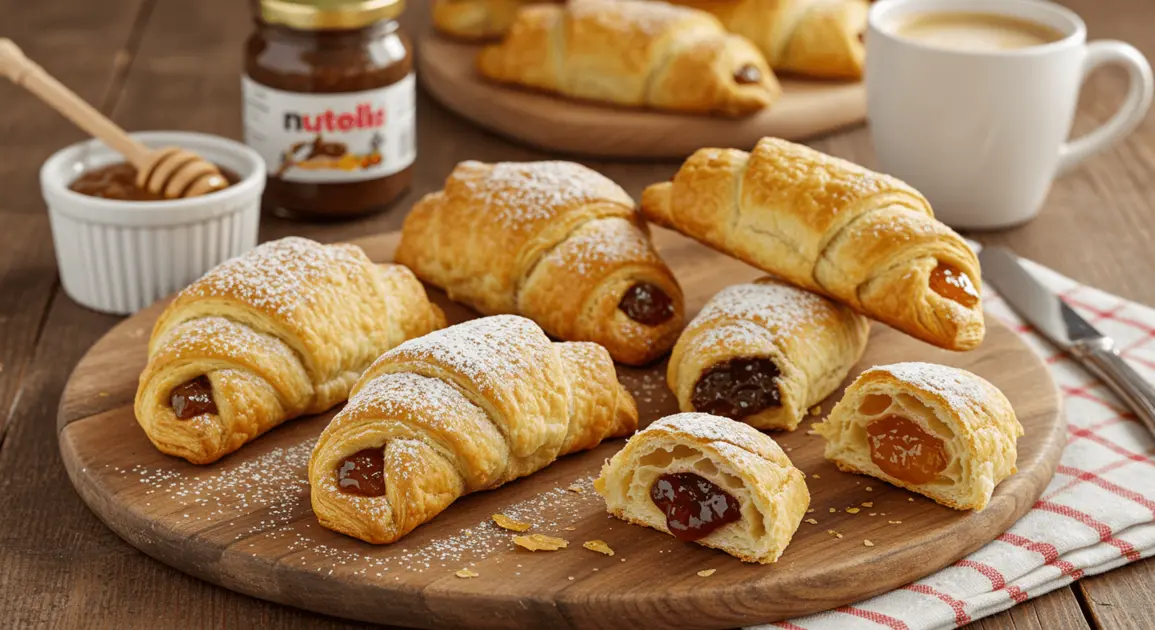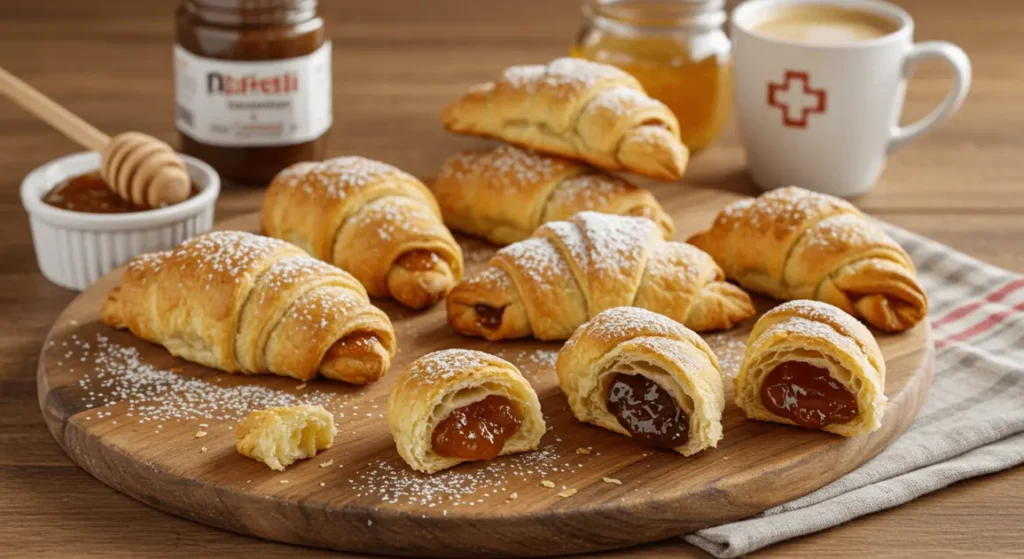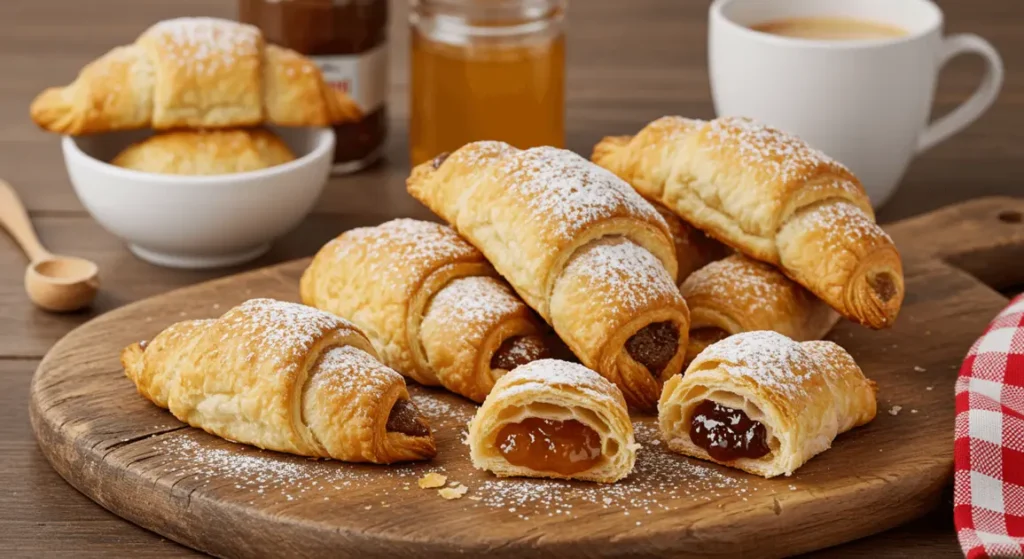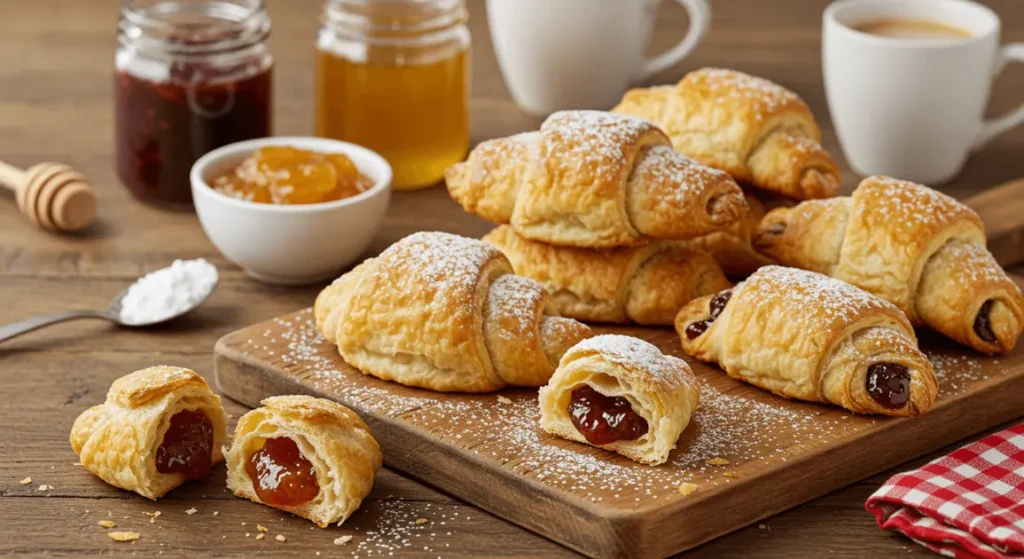
Introduction to Gipfeli
Gipfeli is a kind of traditional Swiss pastry that has occupied a dear place in the Swiss culinary tradition. Characterized by its flaky, buttery layers and extremely tender texture, this crescent-shaped delicacy reminds many people of the French croissant but has some peculiar features that distinguish it from all other similar pastries. The history of Gipfeli dates back to the beginning of the 19th century, when the very first specimen emerged as a typical breakfast food in Swiss homes. It later crossed the border, tantalizing foodies’ taste buds around the world.
Indeed, Gipfeli represents an important component of Swiss culture. More than a pastry served for breakfast, it’s comfort, tradition, and bonding—it’s all rolled into one. Quite noticeably, every weekend, one can spot a family congregating at the dining table and relishing freshly baked Gipfeli, with a cup of coffee or hot chocolate served alongside. Its aroma wafts from the bakeries of Switzerland and tempts passersby into indulging in this favorite pastry. Whether with or without topping, sweetened or salted, Gipfeli are an integral element of Swiss food identity, embodying the philosophy of high-class artisanal bakery products.

Authentic Swiss Gipfeli Recipe: Flaky, Buttery Pastries You Can Make at Home
Ingredients
Dough
- 250 g unsalted butter, chilled
- 500 g all-purpose flour (plus extra for dusting)
- 300 ml whole milk, lukewarm
- 7 g active dry yeast
- 50 g granulated sugar
- 1 tsp salt
- 1 large egg (optional, for egg wash)
Optional Fillings:
- Nutella or chocolate spread
- Homemade fruit jam (e.g., strawberry, apricot)
- Thinly sliced prosciutto or salami
- Cinnamon sugar
- Grated cheese (e.g., cheddar, Parmesan)
Toppings:
- Coarse sugar (optional, for sprinkling before baking)
- Chopped nuts or seeds (optional)
Instructions
- Provide step-by-step instructions with clear actions. Activate the Yeast: In a small bowl, combine the warm milk, 1 teaspoon of sugar, and the yeast. Stir gently and let it sit for 5–10 minutes until frothy.Mix the Dough: In a large mixing bowl, sift together the flour, remaining sugar, and salt. Add the activated yeast mixture and mix until a soft, sticky dough forms. Knead the dough on a lightly floured surface for 10 minutes until smooth and elastic.Let It Rise: Shape the dough into a ball, place it in a greased bowl, cover with a damp cloth, and let it rise in a warm spot for 1–1.5 hours, or until doubled in size.Prepare the Butter Block: Flatten the chilled butter between two sheets of parchment paper into a rectangle slightly smaller than the rolled-out dough.Laminate the Dough: Roll out the risen dough into a rectangle, place the butter block in the center, fold the edges over the butter, and seal tightly. Roll it out again and fold it into thirds like a letter. Repeat this process twice, chilling the dough for 30 minutes between folds.Shape the Gipfeli: Roll out the laminated dough into a large rectangle. Cut it into long strips, then slice diagonally into triangles. Roll each triangle from the wide end to the tip, curling the ends slightly to form crescents.Let Them Proof: Place the shaped Gipfeli on a lined baking sheet, cover with plastic wrap, and let them rise for 30–45 minutes.Bake: Preheat the oven to 200°C (400°F). Brush the tops with beaten egg wash and sprinkle with coarse sugar if desired. Bake for 15–20 minutes until golden brown.
Notes
Notes
Include helpful tips, variations, or troubleshooting advice.- For healthier options, substitute up to 50% of the all-purpose flour with whole wheat, spelt, or rye flour.
- Reduce butter by replacing some of it with olive oil or coconut oil for a lighter version.
- Experiment with different fillings such as honey, cream cheese, or herbs for unique flavors.
- Store leftover Gipfeli in an airtight container at room temperature for up to 2 days or freeze for longer storage.
Table of Contents
Historical Background of Gipfeli
Gipfeli is deeply associated with the broad history of European pastry, notably French and Austrian. While not precisely known for its origins, many culinary historians find the roots of Gipfeli dating back to the early 19th century. One such theory is that it was inspired by the Austrian kipferl-a yeast roll of similar shape that dates back to the 13th century. During the Habsburg era, when trade routes were flourishing and cultural exchange increased, this kipferl made its way into Swiss kitchens, where it underwent significant changes, as we now know, to Gipfeli.
From Simple Bread Roll to Flaky Pastry: The Transformation of Kipferl into Gipfeli
The transformation from kipferl to Gipfeli follows several trends. Kipferl originated as a sort of simple, non-laminated bread roll, albeit made with the finest wheat flour, milk, and lot of butter. It wasn’t until later that Swiss bakers started to experiment with the technique of lamination, or layering dough with butter, which gives the Gipfeli its signature flakiness. The dough was folded multiple times, creating hundreds of thin layers that would puff up beautifully when baked. By the middle of the 19th century, the Swiss version had come to be a lighter and more delicate pastry than its Austrian counterpart.
Cultural Crossroads: How Swiss Precision and French Patisserie Shaped Gipfeli
Cultural influences played an important role in shaping the course of evolution that Gipfeli would take. The position of Switzerland at the crossroads of the Germanic, French, and Italian cultures meant various culinary traditions merged within its borders. The influence of French patisserie techniques, especially the painstaking craft of laminating dough, was immense in refining Gipfeli. In addition, Swiss precision and quality made sure that every batch that came out met stringent standards, further elevating the status of this pastry.
Regional Twists: How Different Parts of Switzerland Customize Their Gipfeli
Regional Variations: Different regions of Switzerland have given their own spin to Gipfeli. Where it is German-speaking, for example, the dough is heavier and richer, with sometimes more butter in it. The French-speaking cantons like their pastry lighter and airier, closer to the way the French make croissants. Meanwhile, bakers in the Italian-speaking region of Ticino may give their version subtle hints of olive oil or herbs, reflecting local tastes and flavors.
Modern Innovations: Adapting Gipfeli to Meet Today’s Dietary Preferences and Tastes
Gipfeli also changed over time to satisfy contemporary tastes and food innovations, like whole wheat and gluten-free Gipfelis, never compromising on flavor and texture; a variety of fillings are found, which go from the well-known Nutella and jam to ham and cheese, just making Gipfeli complete, whether needed sweet or salt.
A Tradition of Warmth: Gipfeli as a Symbol of Swiss Hospitality and Artisanal Craftsmanship
While those are variations, the spirit remains the same-testament that Gipfeli is only one of those classic Swiss pastry items; from its humble beginnings as a bread roll, this journey into a sophisticated multilayered delight underlines the rich tapestry of Swiss culinary traditions and the timeless magic of artisan baking. Today, as one enjoys the Gipfeli in cozy alpine chalets or cafes, it conjures up and still warms people with this sense of tradition-a symbol, really, of Swiss hospitality and craftsmanship.

Ingredients Needed for Gipfeli
Selection of ingredients to produce the perfect Gipfeli is indispensable for the required flaky texture and richness that can be produced in this pastry. The vital components include all-purpose flour, butter, milk, yeast, sugar, and salt. Every ingredient involved in making the pastry will contribute to its structure, taste, and ultimately to your eating experience.
All-Purpose Flour: This provides the backbone to the Gipfeli dough, giving it the needed structure and elasticity. Use a good-quality all-purpose flour with a moderate protein content, usually in the range of 10-12%. The higher the protein level, the chewier the texture will be, while a lower level makes for a more tender crumb. Make sure the flour is fresh; stale flour gives an unpleasant taste and affects the rise of the dough.
Butter: Realize the most critical choice concerning realizing the characteristics in Gipfeli using the right kinds of butter. Prefer unsalted for better handling or control on salt amount throughout this recipe. Usage of high-fat butter at a rate approximately near 82 percent is preferably allowed since more water means only producing crispy air-rich layers, but European butters are quite accepted due to a rich, delicious flavor coupled with a great, high composition of fat. Chilled butter is best for the lamination process so it does not melt too quickly while rolling and folding.
Milk: Most of the whole milk is used for its addition of moisture and richness to the dough. It also is helpful in keeping the final product tender. Some whole milk can be replaced with half-and-half or cream for lighter texture, if desired. Doing so, however, affects its nutritious value. It is advisable to warm the milk up to lukewarm before mixing it with yeast to effectively activate it.
Yeast: Active dry yeast or instant yeast will work for Gipfeli. Yeast will give the dough rise and a light, airy texture. Yeast needs to be adequately activated: mix it with milk at room temperature and just a little bit of sugar. The mixture needs to become frothy; it is then ready to be mixed into the flour mixture. This step ensures that yeast will be active and work its magic.
Sugar: A small addition of sugar amplifies the sweetness of the Gipfeli, balancing with the richness provided by the butter. Granulated sugar is typical, but if you will, you might experiment with alternatives like brown sugar or honey when you want an almost caramel-like depth in that sweetness. However, be rather careful not to overdo this, as sugar in excess has the tendency of hindering yeast’s rising action.
Salt: Salt is needed to give the Gipfeli depth in flavor, but it really brings out the other flavors involved and cuts into the sweetness contributed by the sugar. Fine sea salt or kosher salt is best, since they will dissolve directly into the dough. Use a pinch, no more, as it would make the pastry overpowering.
Also, others are used optionally to enhance the greatness of the pastry. You can add eggs to make it richer and golden yellow in color. The vanilla extract adds a delicate aromatic flavoring, which is suitable, especially if the Gipfeli are served with sweet ones. Those who love some nutty flavor can add almond extract or finely chopped nuts to the dough or sprinkling them on top just before baking.
Ultimately, when you are going for your selection of goods, all should come before quality and freshness. Fresh means being functional during the process of baking, whereas the quality guarantees that its taste and texture become just right. Properly store flour, yeast, and butter to keep them more efficient. Store flour in an airtight container in a cool, dry place; butter in the refrigerator; and yeast in the freezer, making it stay longer in good condition.
By choosing each ingredient to the best possible standard and preparing all precisely, you create a situation conducive to a successful Gipfel-making. Careful choices actively allow for the best combination of simple ingredients into quite an exquisite pastry worthy of its rich history.

Step-by-Step Instructions in Making Gipfeli
In creating the perfect Gipfeli, there are several fine details that require both skill and patience. From making the dough to the crucial lamination steps, every stage is an important part of achieving the required flakiness and flavor. Below there is a complete guide to making this exquisite Swiss confection.
Making the Dough
First, activate the yeast. In a small bowl, mix warm milk (about 110°F/43°C) with one teaspoon of sugar and add the yeast. Gently stir, then leave for approximately 5-10 minutes until the mixture rises to foam. This shows that your yeast is alive and good to use.
In a large bowl, sift together the flour, remaining sugar, and salt. Add the activated yeast liquid with other liquid ingredients, such as eggs, melted butter, and cream. Mix well until a soft dough forms.
Laminating The Dough
Once the dough has risen properly, the lamination process starts, which is the essential stage in achieving flaky layers in Gipfeli. Using a rolling pin, start by turning the dough onto a floured surface, pressing it down with your hands to allow some of the air to escape. First, roll out the dough on a board into a rectangle that is approximately 12 by 18 inches or 30 cm by 45 cm, taking care to keep an even thickness throughout.
Make the butter block. Take one piece of chilled unsalted butter and place it between two sheets of parchment paper. With the aid of a rolling pin, pound the butter into a flat rectangular sheet a bit smaller than the rolled dough, approximately 20 cm by 40 cm or 8 inches by 16 inches. It should be cold but pliable. Remove the parchment paper and lay the butter block on the center of the dough rectangle. Making sure to fully enclose it, fold the edges of the dough over the butter, making sure to seal all seams tightly.
Roll the dough again to a larger rectangle without changing its dimensions, just as before. Now to the folding: fold the dough into thirds like a letter folded into an envelope. This brings about three layers of butter sandwiched between layers of dough. Wrap the dough in plastic wrap and refrigerate for about 30 minutes, which will allow the butter to firm up again.
Repeat the rolling and folding process two more times, chilling for 30 minutes in between each fold. After being folded for the third time, chill the dough for an hour to relax the gluten and set the butter layers.
Shaping the Gipfeli
Now that the dough is duly laminated and refrigerated, it’s time to shape it. Take the dough out of the refrigerator and allow it to stand at room temperature for around 10 minutes to soften it. Roll the dough on a lightly floured surface into a big rectangle, approx. 1/4 inch thick.
Slice the dough into strips using a pizza cutter or a sharp knife, then diagonally cut the strips in half to form long triangles. Each triangle should measure approximately 8 inches (20 cm) wide at the base. To form the classic crescent shape, pull the base of each triangle and roll it firmly up from the wide end to the pointed end. Tuck the ends underneath to form the Gipfeli’s signature curved shape.
Put the formed Gipfeli on a parchment-lined baking sheet with enough space between them to permit expansion while baking. Loosely cover the sheet with plastic wrap and allow the Gipfeli to rise at room temperature for another 30-45 minutes, or until they look puffy.
Baking the Gipfeli
Preheat the oven to 400°F (200°C). Egg wash the tops of the Gipfeli with a beaten egg for glaze while the oven is heating up. If desired, sprinkle a little sugar or coarse salt on top for added flavor and texture.
Place the Gipfeli in the oven and bake for approximately 15-20 minutes, or until golden brown. Watch them so that they do not get over-brown, particularly if your oven is hot. Turn the baking sheet midway through the cooking time to encourage even baking.
When finished, take the Gipfeli out of the oven and let them cool on a wire rack for a little while. Serve warm for the best results, with your favorite spreads, jams, or just plain.
By heeding these step-by-step instructions, you can become a master Gipfeli preparer. While the process might appear to be time-consuming, the end result of flaky, buttery heaven is well worth the trouble. The more you practice, the more you will refine your technique and introduce this wonderful Swiss tradition into your own home.

Gipfeli Adaptations and Variations
Therefore, while the original Gipfeli recipe is undoubtedly a success, you can totally innovate and get creative to appeal to different tastes and dietary needs. Not only do these variations make Gipfeli recipe more versatile, but they enable more people to partake in it, which is really great!
Sweet and Savory Fillings: Elevating Plain Gipfeli to New Heights
An ultra-popular method of mixing things up is by incorporating all manner of fillings, making the plain Gipfeli a great foundation for sweet and savory treats alike. If you’re in the mood for something sweet, consider filling the Gipfeli with a spoonful of Nutella, a dollop of homemade fruit jam, or even a pinch of cinnamon sugar before rolling it up. These tasty additions completely jazz up the pastry, elevating it to a whole new level from the standard recipe. If you would like something savory, you could add chopped herbs, some grated cheese, or even very thin slices of cured meats like prosciutto or salami.
Healthy Twists: Experimenting with Different Flours for a Nutritious Gipfeli
You can also experiment by using different types of flour. You can substitute whole wheat, spelt, or rye flour for up to 50% or even 100% of the all-purpose flour to make the Gipfeli healthier. Whole wheat flour will give it a nice nutty taste and make it a bit denser, while spelt will give it a subtle earthy taste that goes incredibly well with the buttery layers. Rye flour, with its strong personality, can add an interesting complexity, though it is best utilized in small amounts to preserve the lightness of the pastry. Gluten-free flour mixtures are also available for people with dietary limitations, so that everyone may partake in this Swiss treat.
Butter Alternatives: Reducing Calories Without Compromising Flavor
If you’re careful what you eat, reducing the butter or replacing it with healthier alternatives can allow you to indulge in your food without the calories. You can substitute some of the butter with olive oil or coconut oil, which not only adds an interesting flavor but also reduces the saturated fats. Adding Greek yogurt or applesauce to the dough will also keep it moist and reduce the amount of butter you require, creating a tangy and no less delicious Gipfeli.
Creative Toppings: Adding Crunch and Shine to Your Gipfeli
You can certainly get creative with toppings to personalize your Gipfeli to your liking! Instead of simple egg wash, how about brushing them with melted chocolate, honey, or maple syrup prior to baking? They’ll not only be super shiny but also sweeter. And if you’re looking for a crunch, sprinkle some chopped nuts, seeds, or coarse sugar on top before placing those naughty buns in the oven. They add to the sensory experience and cause each bite to be more memorable.
Regional Inspirations: How Local Ingredients Shape Unique Gipfeli Versions
You know, regional twists really show how flexible Gipfeli recipes can be. In some parts of Switzerland, bakers like to throw in local ingredients to capture the local vibe. For instance, up in the Alps, you might find pine nuts or dried fruits like cranberries and apricots mixed into the dough, kind of mirroring the beautiful scenery around them. And over by the coast, they might go for seafood fillings like smoked salmon or crab, giving a fresh spin on the classic recipe.
Global Twists: How International Cultures Put Their Own Spin on Gipfeli
So, outside of Switzerland, various cultures have placed their own twist on Gipfeli, which is really neat. In Japan, they’ve begun creating matcha-flavored Gipfeli, combining that green tea bitterness with the buttery delight of the pastry. In the Middle East, they add spices such as cardamom or saffron to make it their own. All these various interpretations are a testament to how well-liked Gipfeli is and how much creativity you can apply to it!
Preserving Tradition: Balancing Innovation with Classic Gipfeli Characteristics
No matter what you alter, it’s so important to preserve the integral things that make Gipfeli so special: that flaky texture, buttery flavor, and its beautiful crescent shape. With every alteration, you must follow the basic principles of the original recipe but with new flavors and textures being introduced. By trying out these variations, home bakers and professional chefs can keep giving Gipfeli’s tradition its due while also getting innovative in the kitchen.
Serving Suggestions and Pairings for Gipfeli
Serving Gipfeli is not just about putting a nicely baked pastry on a plate; it’s about presenting it in a way that showcases its delicate flavors and textures. When planning to serve Gipfeli, you need to think about beverages and side dishes that complement the pastry’s inherent goodness without overpowering it. Here are some expert tips and recommendations for serving and pairing Gipfeli so you can get the most out of it.
Timing is Key: Serve Gipfeli Fresh from the Oven
First and foremost, timing the time you eat them is crucial. Gipfeli is best served fresh from the oven, crunchy all over and smelling heavenly. You would want to serve them warm so you can get the most out of that buttery scent that fills the air as soon as they’re out of the oven. Let the Gipfeli cool down a bit so you can hold them without burning your hands, but keep them warm enough for a good bite every time.
Plain or Topped: Enjoying Gipfeli with Sweet and Savory Additions
If you’re a straightforward type of person, plain Gipfeli is the way to go. The flaky buttery layers are so tasty and make for a warm start to any meal. But if you feel like mixing things up a little, there are plenty of toppings that can take your Gipfel to the next level. Sweet-tooth fans can treat themselves to some homemade jam, marmalade, or even a drizzle of honey, which complements the buttery richness of the pastry beautifully. You can definitely spread some cream cheese, clotted cream, or mascarpone for that creamy texture juxtaposed with the crunchy outside.
Luxury Pairings: Hot Chocolate, Champagne, and More
Rich hot chocolate, especially an artisanal one, is another luxurious pairing. The velvety, cocoa-infused drink pairs well with the light layers of pastry, making a rich dessert that’s perfect for chillier months. Should you desire something somewhat more unexpected, a champagne or sparkling wine pairing with Gipfel is a festive choice. The bubbles in the bubbly provide a nice foil to the buttery pastry, making a party-perfect pairing.
Buffet Brilliance: Presenting Gipfeli with Other Breakfast Treats
Apart from serving them separately, you can also present Gipfeli very attractively on a buffet or a communal platter. Simply mix them with other breakfast treats such as fresh fruits, yogurt parfaits, and granola bowls for a nice, balanced spread that also looks good. And if you want to give it a little extra oomph, sprinkle some edible flowers or fresh herbs on the serving platters for a burst of color and a pleasant aroma that complements the golden pastries.
DIY Delight: Hosting a Gipfeli Bar for Personalized Pastries
When hosting brunches or parties, consider setting up a DIY Gipfeli bar where guests can create their own pastries using a variety of spreads, cheeses, and meats. This interactive element not only engages the guests but also allows for personalization so each person has a combination they will like. Serve with small plates, napkins, and utensils for easy serving, encouraging guests to have several different kinds.
Presentation Matters: Elevating Gipfeli from Snack to Gourmet Delight
Lastly, remember that presentation is equally as vital as taste. Serve Gipfeli on attractive, rustic wooden boards or elegant porcelain plates to create a cozy ambiance. Experiment with garnishing decorative baskets or tiered servers for a more refined setting, which raises the level of the pastry from simple snack to gourmet delight.
Customize Your Gipfeli: Making Every Bite Special
If you think about how to pair and serve Gipfeli, you can really make a simple pastry something special. Whether you’re munching on it solo, hanging out with friends, or serving it at a big party, Gipfeli’s got that laid-back vibe and classic style that makes it perfect for any situation. With the right sides and presentation, you can nod to its Swiss roots while adding your own fun twist to it.
Conclusion: The Timeless Popularity of Gipfeli
In summary, Gipfeli is a timeless testament to Switzerland’s rich culinary heritage, representing the ideal combination of history, craftsmanship, and taste. Its evolution from a humble bread roll to a multi-layered, sophisticated pastry is a testament to the creativity and perseverance of Swiss bakers, who have refined their craft over generations to create this ico
Choose what you like from the breakfast menu to start your day happily
what did you think about this recipe?
cool recipe
thx for this